It’s easy to be confused by some of the terminology used in discussions about RVs. We recently published a post explaining what the term “wet bath” means, but what is a dry bath in a camper, and how is it different from a wet bath?
If you’d like to know, we’ve got you covered. Let’s take a look…
- 1) What is a Dry Bath?
- 2) What’s the Difference Between a Wet Bath and a Dry Bath in a Camper?
- 3) How Do You Use a Wet Bath in a Camper?
- 4) Do All Campers Have Showers?
- 5) What Are Some of the Smallest RVs with Dry Baths?
- 6) Class B RVs:
- 7) Travel Trailers:
- 8) Do You Need to Have a Dry Bath In a Camper?
What is a Dry Bath?
This one’s pretty simple. A dry bath is basically what you’d expect to find in the bathroom of a sticks & bricks house – a toilet, a sink, and a separate shower – though often (but not always) on a smaller scale.
Large Class A motorhomes like ours may have bathrooms that are pretty full scale in terms of size. But many Class C and B RVs and travel trailers are likely to have bathrooms with a smaller footprint overall.
In fact, many Class B RVs and some travel trailers either don’t have a toilet and shower at all, or they have what’s known as a wet bath.
What’s the Difference Between a Wet Bath and a Dry Bath in a Camper?
The difference between a wet bath and a dry bath is relatively significant in one sense: in a wet bath, everything gets wet when you use the shower.
A wet bath is designed with this in mind, though, so that’s not as bad as it sounds… though it’s not exactly ideal, either.
A wet bath is made from material that can get wet, toilet included, and generally has a cover over the toilet paper holder. But anything in a wet bath that you don’t want to get wet, needs to be removed from the room prior to showering.
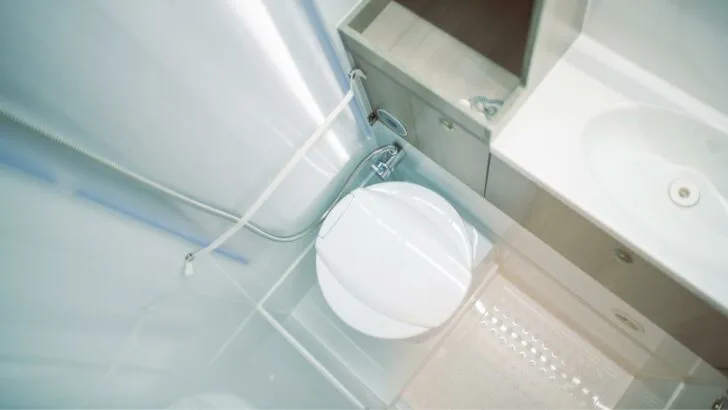
A wet bath is designed so that everything in the tiny bathroom space can get wet – and it does!
How Do You Use a Wet Bath in a Camper?
Even though you have to remove anything that you don’t want to get wet when you use the shower in a wet bath, they’re very easy to use. One of the biggest drawbacks, though, is size. Wet baths tend to be very small. And unless you’re 6 years old (or a contortionist), showering in a wet bath can require some flexibility and ingenuity.
That said, if you’ve been out on the trails all day and you’ve just returned to the camper to relax for the evening, a nice hot shower feels good… no matter where you’re standing.
Once you’ve finished showering in a wet bath, it’s best to use a squeegee to pull the water off of the walls and into the shower drain. This helps to keep moisture from accumulating in your RV, a very important goal.
Microfiber towels are also handy after using the shower in a wet bath. You’ll want to dry off all of the moisture the squeegee left behind so that the next person who needs to use the toilet isn’t using a wet toilet.
Because wet baths are small, it doesn’t take long to squeegee and towel dry the little room, but it’s a system you need to establish and remain dedicated to in order to make a wet bath work well for you.
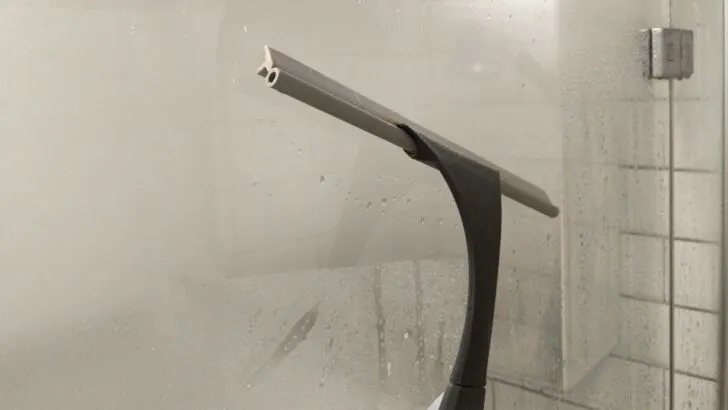
A quick squeegee of the shower walls after each shower is beneficial whether you have a wet bath or a dry bath as it helps to keep unwanted moisture at bay.
Do All Campers Have Showers?
Not all campers have showers. Some campers have a wet bath, some have a dry bath, and some have only an outdoor shower, while other campers have no form of shower at all.
Some campers have very usable showers that are fairly unusual. For about ten years (1995-2005) Winnebago made the Rialta, a popular and unique little RV that we still see on the road today. The Rialta’s bathroom is essentially a pull-out room. When you need to shower or use the toilet, the bathroom extends out into the center aisle of the RV, giving you space to do what you need to do. Interestingly, the Rialta’s shower drains into its tiny black tank, so Rialta owners need to make sure there’s room in the black tank before showering, otherwise, they may find themselves standing in a pool of ………………. black water. ????
Older model Roadtreks used some showering ingenuity as well. They’ve got shower drains on the floor of the aisle, and room for a shower curtain to wrap around you as you shower right in the middle of the aisle. Sounds crazy when we describe it, but for many owners of older Roadtreks, it works just fine once they develop a system and become accustomed to showering in this way.
This is how some smaller Class B rigs make the most of the space they have to work with. Still, a dry bath is the preferred option for most RVers, including those who opt for a smaller RV. So, let’s take a look at some of the smallest RVs with dry baths.
What Are Some of the Smallest RVs with Dry Baths?
While not an all-inclusive list, the following Class B RVs and travel trailers, while relatively small, still offer a dry bath for the comfort and convenience of their owners.
Class B RVs:
Airstream Atlas
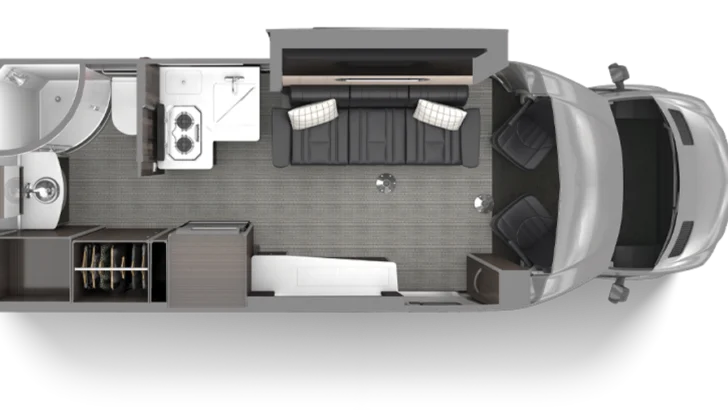
Built on a Mercedes chassis, the Airstream Atlas is a 24′ Class B RV that packs a lot of punch into that small amount of space.
The Atlas offers a fairly spacious bathroom at the rear of the RV that includes a large shower that’s in a separate space from the toilet and vanity. Airstream dedicated the entire rear portion of the Atlas to a dry bath, with the enclosed shower encompassing an entire corner of the rear of the rig, a toilet situated beside it, and a sink located across the back of the camper.
Coach House Arriva
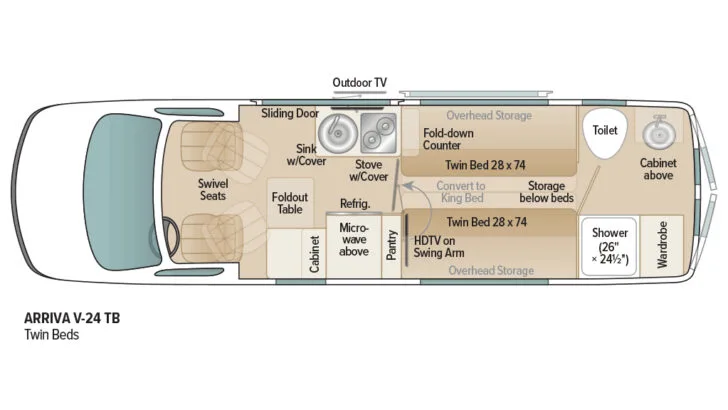
With the Arriva 24B, Coach House brought a dry bath to the rear of the rig as Airstream did, but with this rig (also built on a Mercedes chassis), we find the toilet and sink located across the aisle from the 26” x 24.5” shower.
B+ Leisure Wonder
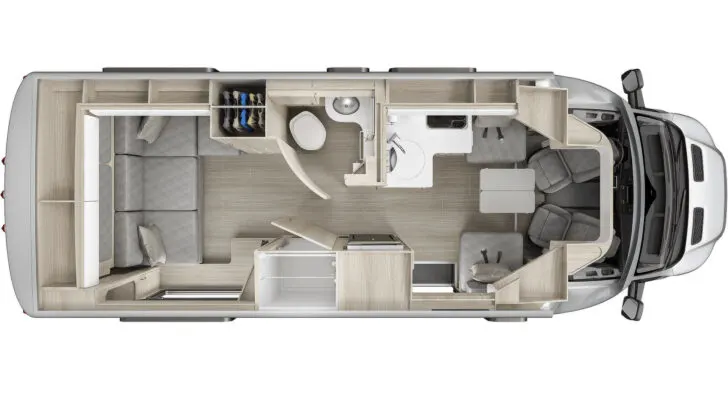
The B+ Leisure Wonder, built on a Ford chassis, offers several floor plans, some of which use the center of the rig for the dry bath components while others use the back of the rig.
The floor plans that use the center of the rig place the toilet and sink in an enclosed space, with the enclosed shower directly across the hall.
The other floor plans offer the sink, toilet, and shower in a separated space along the rear of the RV.
Travel Trailers:
Coachmen Clipper 17FQ and 17BH
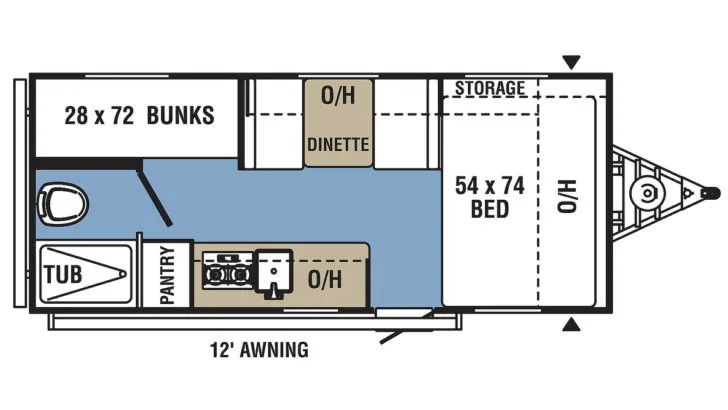
Coachmen offers dry baths in the Clipper models of their travel trailers.
The 17FQ is a 20.5” camper that situates the bathroom at the rear of the camper with the toilet in the center and the enclosed shower and vanity on opposite sides of the toilet.
The 17BH is the same size travel trailer as the 17FQ, but instead of offering a shower, the BH offers a small bathtub which is situated in a rear corner of the camper with a toilet in the middle and a set of bunk beds on the opposite side, all obviously in separate enclosures.
Forest River Wildwood FSX 177BHX
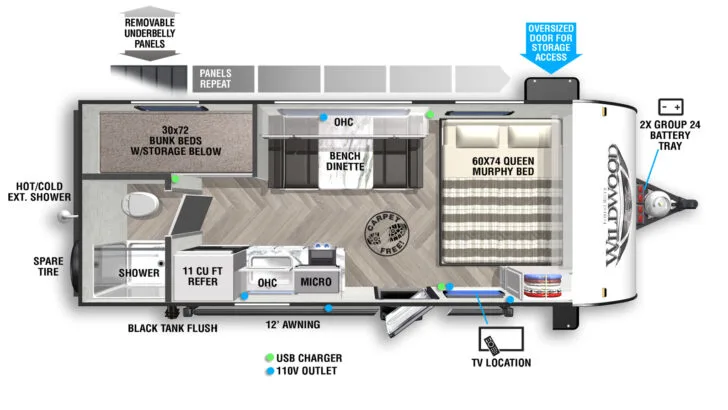
Forest River’s Wildwood FSX 177BHX is 22’ long and weighs less than 4,000 pounds, but manages to encompass a separate toilet and shower at the rear of the rig.
The shower sits in one corner while the toilet is in the middle and a separate area with a set of bunk beds is in the opposite corner. This camper also has an outdoor shower at the back of the RV.
Prime Time Avenger 16BH
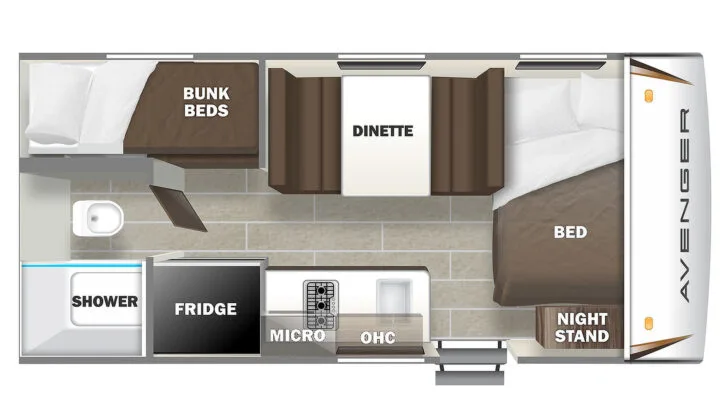
Prime Time’s Avenger also locates its dry bath in the rear of the camper beside a set of bunks. (Photo/rendering credit: Prime Time RV)
Prime Time Manufacturing has managed to fit a dry bath in its Aventure 16BH, a 20’7” travel trailer weighing in at just over 3,000 pounds.
This little travel trailer presents the toilet in the middle of the back wall of the rig with a separately enclosed shower beside it in one corner and, like the Coachmen and Forest River campers, a set of bunk beds on the opposite side of the rig.
Venture Sonic Lite 150VRK
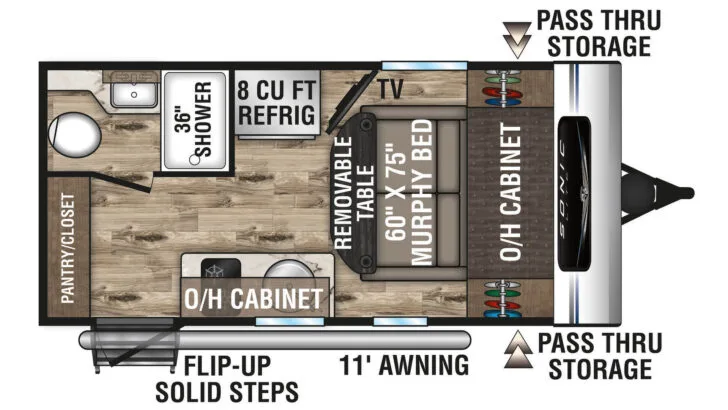
The Venture Sonic Lite 150VRK is a 19’ camper weighing just over 3,000 pounds. In this little rig, one entire rear corner is dedicated to the toilet, sink, and separately enclosed shower. If you’ll envision a rectangular space along one side of the rear of the camper, the toilet and sink are situated in the corner, and the enclosed 36” shower takes up the space toward the center of the RV.
As you may have noted, the enclosed showers in all of these rigs are quite small, but this is a trade-off where a dry bath is a priority in a small space.
Despite the diminutive sizes of the showers, however, we suspect that the folks who enjoy a shower in any of these rigs are happy not to have to squeegee and dry them afterward.
Do You Need to Have a Dry Bath In a Camper?
You don’t need to have a dry bath in a camper, but it’s more convenient for several reasons. First, there’s no need to drag items out of the bathroom in order to shower without getting them wet.
There’s also no need to squeegee water from the walls (and everything else) and dry the room with a towel every time you shower.
And finally, with a wet bath, no one can use the toilet when someone else is using the shower. This wouldn’t be an issue for anyone traveling alone, of course, but could potentially be an issue if you’re traveling with a companion or two.
As we always say, though, any type of rig that gets you out enjoying nature and the adventure of traveling is a great rig, wet bath, dry bath, or no bath.
We all tend to appreciate more comfort, of course, and the luxury of traveling with any type of bathroom is certainly something to appreciate.
Geek Out with Us Every Week
Join our newsletter to learn about all things RV-related. Every week we offer free tips, tricks, product reviews, and more to our online community of RVers. So, whether this is your first time on the road or you’re a seasoned expert, we’d love for you to geek out with us!

